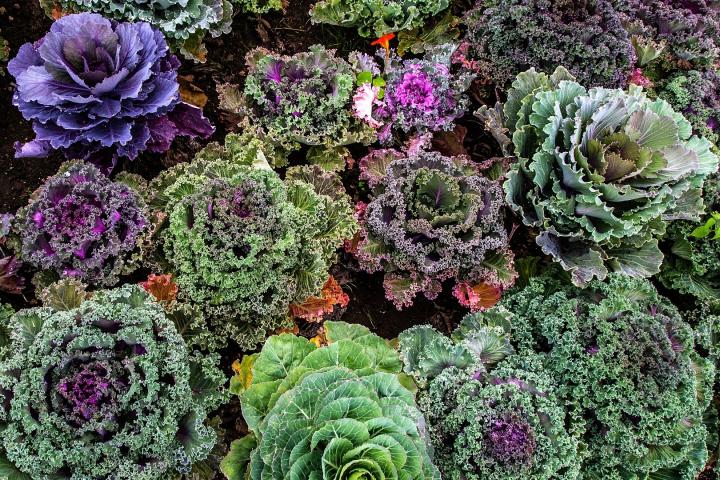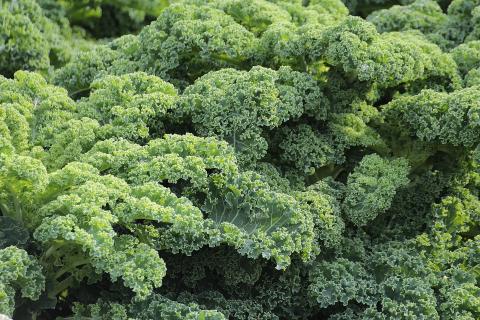Kale is an exceptionally hardy cold-weather champ that tolerates temperatures from the low 20s down to the upper teens. Cool weather brings out the sweet, nutty flavor of this highly nutritious leafy green. Dive into our Kale Growing Guide for information on planting and growing this hardworking beauty.
About Kale
Kale is a member of the Brassica family, like cabbage, broccoli, brussels sprouts, and other common cole crops. It is a biennial. The first year it has leaves. The second year, the kale blooms and sets seed. The plant dies when the seeds mature.
In the spring, kale can be started from seed indoors and young kale plants can be set out very early (4 to 6 weeks before the last frost). But in many regions, kale is best grown in autumn, when temperatures are cooler. Kale tastes better when the leaves mature in cold weather.
Kale is versatile in the garden, growing well in traditional garden beds, raised beds, or containers, where its ornamental value is appreciated, especially in fall. It’s also versatile in the kitchen and a nutritious addition to salads, stir fries, omelettes, casseroles, and other dishes.
Choosing and Preparing a Planting Site
- Kale does best in full sun, but tolerates partial shade.
- The soil pH should ideally be 6.5 to 6.8 to discourage disease, but kale is tolerant of more alkaline soils up to a pH of 7.5. (Test your pH with a kit from your local cooperative extension office or garden store)
- Based on the soil test, amend your soil with nitrogen-rich compost or blood meal. (If you didn’t test your soil, mix in a few inches of compost).
- Soil needs to drain well.
- When planting, add fertilizer (1-1/2 cups of 5-10-10 fertilizer per 25 feet of row into the top 3 to 4 inches of soil).
When to Plant Kale
Plant kale at any time, from early spring to early summer or even in late summer. Late-season harvests can be made until the ground freezes. Kale seeds can be started indoors or sown directly in the garden.
- For an early summer harvest, direct-sow seeds outdoors as soon as the soil is workable in the spring.
- For a fall or winter harvest, direct-sow seeds about three months before your first fall frost date.
- In early spring, young kale plants can be set out in the garden 4 to 6 weeks before the last spring frost date. If temperatures are likely to dip well below freezing, it’s best to cover young plants at night.
- For a fall harvest, young kale plants can be set out 6 to 8 weeks before the first fall frost. Or, direct sow seeds 3 months before the first fall frost. Plant seeds 1/4 to 1/2 of an inch deep, 1 inch apart in rows 18 to 30 inches apart.
- Kale will withstand hard frosts (25 to 28 degrees F) without experiencing damage. It will even tolerate temperatures in the low 20s to upper teens.
- Kale can also be grown as a winter vegetables under cover or outside in mild winter regions, like the Southwest, Pacific Northwest, and Southeast. They’ll grow and yield all winter long. We suggest speaking to your local cooperative extension to determine if/when you should plant winter vegetables.
How to Plant Kale
- If you’re planting seeds, sow 1/4 to 1/2 inch deep into well-drained, light soil.
- After about 2 weeks, thin the seedlings so that they are spaced 8 to 12 inches apart. Kale likes to have plenty of space to stretch out.
- If you’re setting out young plants (transplants), plant them at the depth at which they are growing in the container. Space 18 to 24 inches apart.
- After planting, water plants well.
Check out this video to learn how to grow kale:
How to Grow Kale
- It’s important to keep kale well watered and fertilized. If rain is inconsistent, provide 1 to 1.5 inches of water each week (about 1 gallon per square foot).
- Regularly feed kale with a continuous-release plant food.
- Mulch the soil to keep down the weeds and keep kale cool. Kale won’t grow in hot weather.
- Mulch the soil again heavily after the first hard freeze in the fall. The plants may continue to produce leaves throughout the winter.
- Cabbageworms are a common pest. Chewed holes are the sign of the green or striped cabbage worm.
- Flea beetles are tiny, usually black. They make tiny holes in the leaves of kale and several other plants.
- Cabbage Aphids are easily solved with a spray of insecticidal soap, but keep your eye out for these tiny bugs which will be clustered between the leaves.
- ‘Vates’, which is a hardy variety and does not yellow in cold weather. It also has curly, blue-green leaves on 15 inch tall plants.
- ‘Winterbor’, which resembles the ‘Vates’ variety, but is frost tolerant.
- ‘Red Russian’, which has red, tender leaves and is an early crop.
- ‘Lacinato’ (aka ‘Lacinato Blue’, ‘Tuscan’, ‘Black Palm Tree’, or ‘Cavil Nero’): heirloom; straplike leaves up to 2 feet long on plants that resemble small palm trees; heat tolerant, and very cold-hardy.
- ‘True Siberian’: large, frilly, blue-green leaves; cold-hardy; pick all winter in some areas.

How to Harvest Kale
- Kale is ready to harvest when the leaves are about the size of your hand.
- Pick about one fistful of leaves per harvest. Start harvesting the oldest leaves first from the lowest section of the plant. (Discard any yellowed or torn leaves.)
- Avoid picking the terminal bud (found at the top center of the plant). That’s the part that keeps the plant productive.
- Kale will continue growing until it’s 20°F. It tastes even sweeter with a touch of frost. (See local frost dates.)
- If you wish to extend your harvest, shield your kale from the cold with row covers. Or, create a makeshift cover with tarps and old blankets propped up by hay bales. Here are a few more season-extending ideas.
- The small, tender leaves can be eaten uncooked and used in salads.
- Cut and cook the larger leaves like spinach, but be sure to remove the tough ribs before cooking.
How to Store Kale
- You can store kale as you would any other leafy green. Put the kale in a loose plastic produce bag and store it in the refrigerator. It should last about 1 week.
- The chill of a moderate frost or light snow improves the flavor of kale.
- Kale has a number of health benefits, as it is rich in minerals and vitamins A and C.
Many people dislike kale because it is so crunchy and dry. It sounds odd, but a great way to make kale more tasty is to massage it!
Kale also makes a great compliment to spinach in a salad (watch this video for great kale salad ideas), and kale chips can be a tasty treat. Find out more about kale and spinach.




